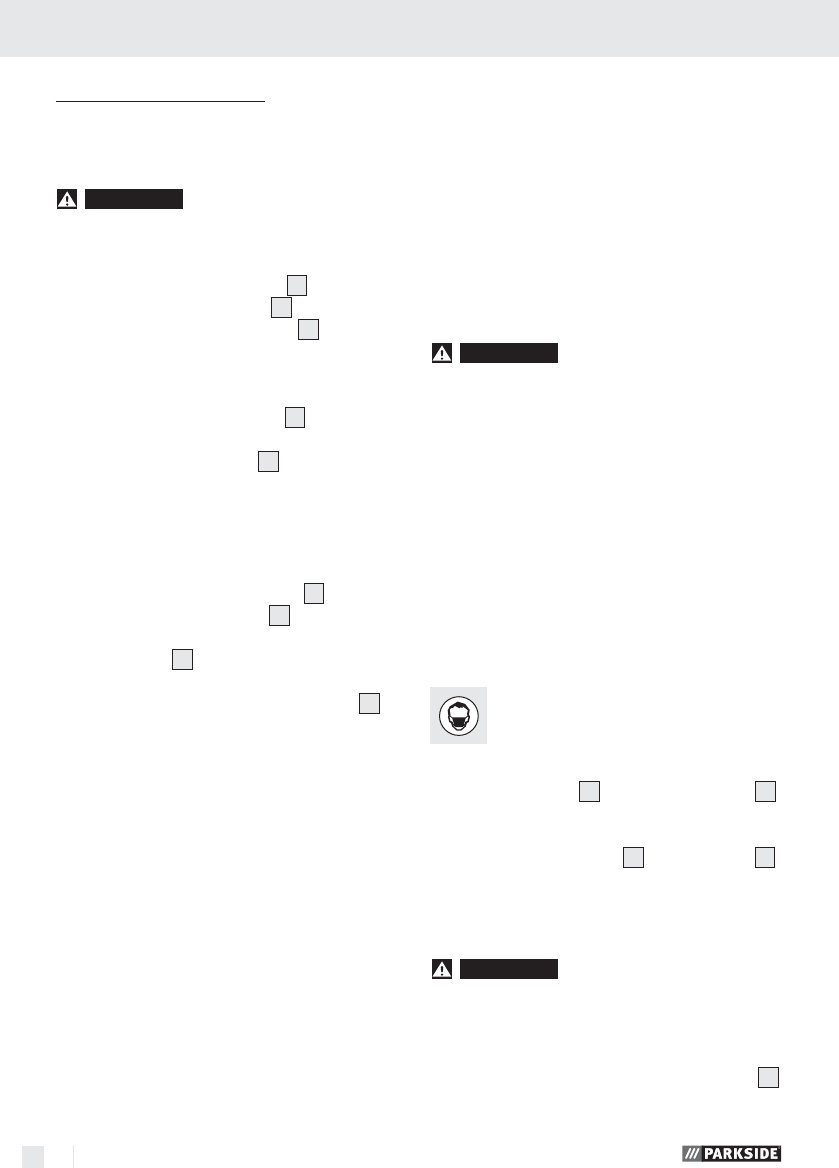
10 GB/IE
Preparing for use
©
Preparing for use
©
Tensioning / changing the
sanding belt
WARNING!
DANGER OF INJURY!
Before you carry out any work on the belt sander
always pull the plug out of the mains socket.
1. Then release the tensioner for the sanding belt
by moving the tensioning lever
10
fully outwards
(see fig. C). The sanding belt
8
can be removed.
2. Next insert a new sanding belt
8
or change
the belt for one suitable for a different material
or one with a different grit size.
IMPORTANT: The direction of the arrows on
the inside of the sanding belt
8
must agree
with that on sander housing.
3. Press the tensioning lever
10
back into its
initial position.
Adjusting the sanding belt path manually:
If the belt does not run centrally when switched on,
you may have to adjust the sanding belt manually.
˽ To do this, turn the adjuster screw
7
on the front
roller until the sanding belt
8
runs centrally.
IMPORTANT: Always make sure that the
sanding belt
8
does not cut into the housing.
Check the sanding belt regularly and if neces-
sary re-adjust it using the adjuster screw
7
.
©
Advice on use
Light sanding pressure is enough:
˽ Apply light sanding pressure only. The weight
of the belt sander alone is adequate to produce
good sanding results. By adopting this approach
you will also prolong the life of your sanding
belts and obtain a smoother workpiece surface.
Sanding and surfaces:
The sanding output and the quality of the surface
finish obtained are determined by the belt speed
and the grade of grit on the sanding belt (see the
section on “Selecting the correct rotational speed
and sanding belt”).
Sanding procedure:
˽ With the sander switched on, bring it into con-
tact with the workpiece and move it forward
carefully. Work in parallel and overlapping
widths. Always work in the direction of the grain
to avoid undesirable transverse sanding marks.
After sanding always lift the device from the
workpiece before switching it off.
©
Vacuum dust extraction
WARNING!
DANGER OF FIRE! There is
the danger of fire when working with electrical de-
vices that have a dustbox or can be connected to a
vacuum cleaner. Under certain conditions the wood
dust in the dust collection box (or in the vacuum‘s
dust bag) may self-ignite, e.g. as a result of flying
sparks generated when abrading metals or metal
objects left in wood. This can happen particularly if
the wood dust is mixed with paint residue or other
chemicals and the abraded particles are hot from
prolonged abrasion. Therefore you must empty the
device’s dust collection box and the vacuum clean-
er’s dust bag before taking a break or stopping
work and always avoid overheating of the abraded
particles and the device.
Wear a dust mask!
Dust extraction with dust box:
˽ Push the dust box
5
on to the adapter port
9
.
Dismantle / remove the dust box:
˽ Press the release button
6
of the dust box
5
and withdraw it towards the rear of the device.
Adapter for external vacuum extraction
(with reducer piece)
WARNING!
EXPLOSIVE MATERIAL!
If there is an explosive mixture of dust and air you
must use a vacuum device especially intended for
that purpose.
DANGER OF FIRE FROM FLYING SPARKS!
Do not use any form of dust extraction (dust box
5
or vacuum extraction device) if you are sanding metal.


















